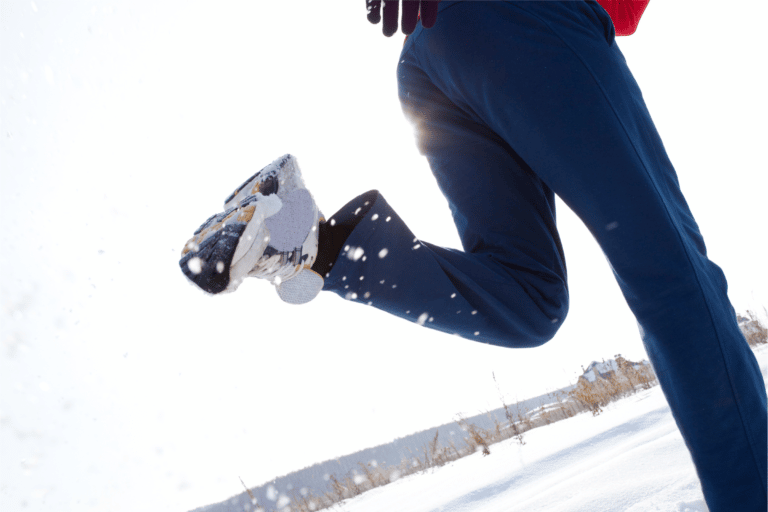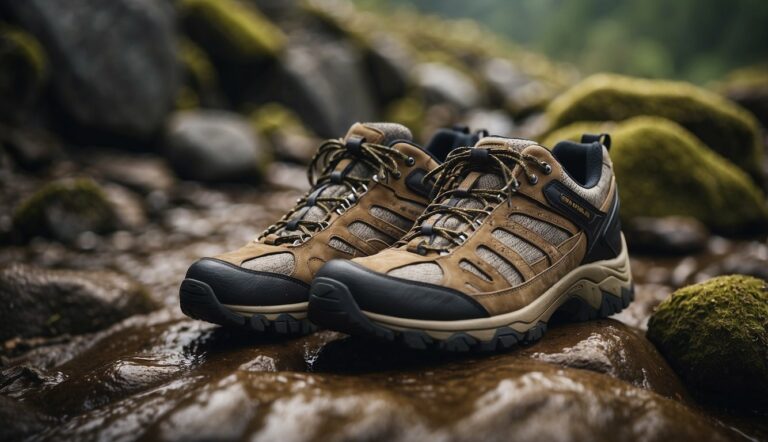Barefoot or Minimalist Trail Running: Advantages, Obstacles, and Transition Tips
Trail running can be vastly different when transitioning from traditional running shoes to a minimalist approach. I believe that adopting barefoot or minimalist footwear, which characterizes running with reduced cushioning and support, can lead to a more natural running form. This change encourages a mid-foot strike and better alignment, which can enhance your running biomechanics and may decrease the risk of common overuse injuries.
However, making the shift should be gradual and informed. I’ve seen runners gain improved ground feedback and heightened sensory experience that can improve balance and agility, but without careful progression, the risk of injury can increase. Starting with shorter runs and paying close attention to good form is crucial for a successful transition.
When considering barefoot or minimalist running, particularly on trails, understanding the balance between the benefits and challenges is key. The potential for a more efficient, natural stride comes with the need to build strength and adaptability in the feet and lower legs. Guidance from an experienced coach, along with patience and perseverance, can create a rewarding and enjoyable running experience on the trails.
Barefoot and Minimalist Running – an Overview
Barefoot and minimalist running have reshaped the running landscape, emphasizing natural movement and a more intuitive connection with the terrain.
Historical Context and the Minimalist Movement
Minimalist running gained prominence with the publication of “Born to Run,” a book highlighting the benefits of running barefoot or with minimal footwear.
This philosophy posits that stripping back to bare bones footwear can reduce injuries and improve running form. Minimalist movement advocates suggest that our ancestors ran effectively without the need for cushioned shoes, and we can too.
Biomechanics of Barefoot vs. Shod Running
In barefoot-style running, runners typically land with a mid or fore-foot strike rather than the heel strike common in shod (shoe-wearing) running. This encourages a running form that is believed to reduce impact stress on the body. Minimalist running shoes aim to mimic this natural barefoot running form while still offering protection from ground hazards.
Potential Benefits of Barefoot and Minimalist Running
Engaging in barefoot or minimalist running facilitates a closer connection to the terrain while strengthening the muscles of the foot. By stripping back to basics, runners often find improvements in technique and a development in a more natural running posture.
Strengthens Foot Muscles
Barefoot running offers a unique workout for the intrinsic muscles of the feet that are often neglected by traditional running shoes. By engaging and strengthening these muscles:
- Arch Support: Increased strength in the foot’s arches.
- Toe Splay: Enhanced ability for toes to spread for balance.
Improves Running Technique
Without the cushioning of standard running shoes, my feet naturally adjust to a more efficient running technique:
- Foot Strike: Transitioning from a heel strike to a midfoot or forefoot strike.
- Sensitivity: Heightened foot sensitivity encourages a lighter, more responsive gait.
Enhances Posture and Cadence
Minimalist running compels me to adopt a running form that promotes a better posture and increases cadence:
- Posture: An upright stance aligns the spine, reducing strain on the back.
- Cadence: Shorter, more frequent strides reduce impact force per step.
Challenges and Risks to Consider with Barefoot Trail Running

As a UESCA certified running coach with extensive experience in trail running, I emphasize that transitioning to these styles of running is significantly different from traditional shod running, and it comes with its own set of challenges and risks.
Risk of Injuries and Overuse
Barefoot and minimalist runners often experience a change in running mechanics. This can lead to overuse injuries such as stress fractures, especially in the feet and tibia, due to reduced cushioning and shock absorption.
It’s important to recognize the body’s need for a gradual transition to adapt to the increased impact forces on harder surfaces. Common injuries include:
- Plantar Fasciitis: Pain in the bottom of the foot due to increased stress.
- Achilles Tendinitis: Overload of the Achilles caused by a lower heel-to-toe drop.
- Metatarsal Stress Fractures: Small breaks in the foot bones from repetitive stress.
Transitioning Challenges
When transitioning to barefoot or minimalist running, it’s critical to avoid doing too much too soon. My advice is to start with short, easy runs, gradually increasing duration and intensity. Be mindful of these transition challenges:
- Muscle Fatigue: Calves and foot muscles may tire quickly as they adapt.
- Technique Adjustment: Learning a new gait and foot strike pattern takes time.
Surface Hardness and Impact Forces
Running on hard surfaces without traditional cushioning increases impact forces, which can strain muscles and joints. Adapting to these surfaces requires a careful and incremental approach. Here are specific risks associated with surface hardness:
- Increased Impact Force: Less cushioning leads to higher forces on the body.
- Hard Surface Risks: Running on concrete or asphalt without protection can increase the risk of injuries.
By understanding these risks and carefully managing your transition, you can safely enjoy the benefits of barefoot or minimalist trail running. Remember that listening to your body and responding to its cues is essential for a successful and injury-free experience.
How to Transition to Barefoot or Minimalist Trail Running
Transitioning to barefoot or minimalist running requires a strategic approach to prevent injury and improve technique. I’ll share my knowledge on how to effectively make the shift, emphasizing the importance of gradual adaptation, proper running form, and strengthening exercises.
Gradual Adaptation and Training Plan
Initial Weeks:
- Begin with walking in barefoot shoes to allow your feet to adapt.
- Limit initial running sessions to 10% of your typical running distance.
Progressive Increase:
- Each week, increase your barefoot running distance by 10%.
- Monitor your body’s response carefully, particularly your calves and Achilles tendon.
Developing the Right Running Form
Foot Strike:
- Transition from a heel strike to a midfoot or forefoot strike.
- Focus on landing softly and under your center of gravity.
Cadence:
- Aim for a higher cadence with shorter, quicker strides.
- This reduces impact forces on the foot and lower leg.
Cross-Training and Strengthening Exercises
Cross-Training:
- Incorporate activities like cycling and swimming to maintain fitness without overloading your feet.
Strengthening Exercises:
- Perform heel drops and toe curls to strengthen your calves and feet.
- Regularly stretch your calves and feet to enhance flexibility and reduce tension.
| Activity | Purpose | Frequency |
|---|---|---|
| Walking in minimalist shoes | Adaptation | Daily |
| Short barefoot runs | Form and Strength | 1-2 times/week |
| Cross-training | Maintain fitness | 2-3 times/week |
| Strengthening Exercises | Build muscle resilience | 3-4 times/week |
By following this structured plan, my goal is to help runners make a successful transition to barefoot or minimalist running, reducing the risk of injury while reaping the benefits of this natural running form.
Choosing the Right Footwear for Minimalist Trail Running
Selecting the right shoes is pivotal for a successful transition to barefoot or minimalist trail running. I’ll guide you through the essential features of minimalist shoes and compare them with traditional running shoes to help you make an informed choice.
Minimalist Shoes Features and Selection
Minimalist shoes foster a more natural running gait by being lightweight and flexible, and they differ from traditional running shoes with less cushioning and a low heel-to-toe drop, often referred to as “zero-drop.” When selecting a pair, look for these specifics:
- Flexibility: The sole should allow your foot to bend and move naturally.
- Thin Sole: Aim for a thickness that provides protection while still allowing you to feel the terrain.
- Fit: The shoe should be snug but not tight, giving your toes room to spread.
Brands like Vibram FiveFingers are renowned for providing a close-to-barefoot experience, with individual toe slots to enhance the natural biomechanics of the feet. Before purchasing, it’s wise to consult a sizing chart specific to minimalist shoes, as the fit may differ from standard running shoes.
Barefoot Shoes vs. Traditional Running Shoes
The key to understanding the difference lies in design and purpose. Barefoot shoes are designed to mimic the barefoot experience on surfaces like grass while providing minimal protection.
Traditional running shoes, on the other hand, feature more cushioning for shock absorption and are typically built with a higher heel drop, offering more arch support and stability.
| Feature | Barefoot Shoes | Traditional Running Shoes |
|---|---|---|
| Cushioning | Minimal to none | Ample cushioning |
| Sole Thickness | Ultra-thin | Thicker for protection |
| Heel-to-Toe Drop | Zero-drop (flat) | Elevated heel |
| Flexibility | Highly flexible | Less flexible |
| Natural Ground Feel | High | Reduced |
| Protection | Basic | Comprehensive |
Personal preference and individual biomechanics play a significant role in deciding between barefoot or traditional shoes. If you’re looking for a shoe that encourages a mid-foot or forefoot landing, aids in strengthening your feet, and enhances your proprioception, minimal shoes might be your preferred choice. However, incorporate them gradually to prevent injury, and consider alternating with cushioned running shoes as you adapt.





